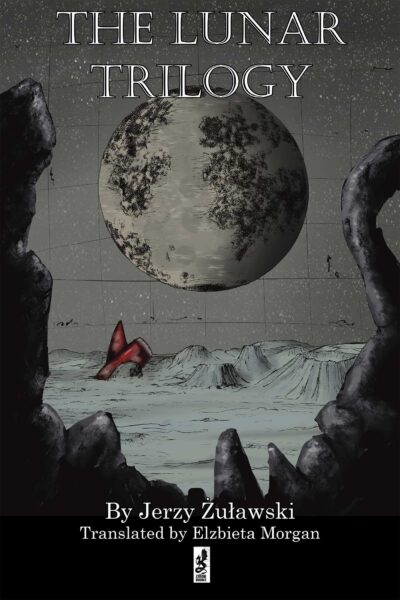 By JERZY ZULAWSKI (Zmok Books; 2020)
By JERZY ZULAWSKI (Zmok Books; 2020)
Another example of a publication that should have received far more attention than it did. It’s the premiere English version (not counting a crude 2017 Google translated attempt) of Jerzy Zulawski’s Polish language LUNAR TRILOGY, a three part science fiction epic from 1901-11. Widely revered throughout Europe (and a key inspiration on Zulawski’s fellow countryman Stanislaw Lem), these novels are best known in the English speaking world as the inspiration for the 1988 film THE SILVER GLOBE/Na srebrnym globie, directed by the author’s descendent Andrzej Zulawski.
This publication by Zmok Books is far from ideal in terms of presentation. The trade paperback is rather cheaply manufactured (it arrived with multiple cover tears and creases, which only increased as I read it) and filled with typos—a shame, as the translation by Elzbieta Morgan is quite strong. I’ll also praise the publisher’s decision to include this trilogy in its 631 page entirety rather than in three separate volumes, as it works best in all-in-one form.
The first volume is ON THE SILVER GLOBE, initially serialized in a Polish literary journal from December 1901 to April 1902. Thus its publication nearly paralleled that of H.G. Wells’ FIRST MEN IN THE MOON (1900-01) and beat John W. Campbell’s THE MOON IS HELL (1950) to the punch by nearly fifty years. As with those texts, ON THE SILVER GLOBE describes a trip to the moon, undertaken by several astronauts who, together with a pack of dogs, do their best to set up a human colony in this inhospitable terrain.
This book’s lunar landscape, containing lakes, abundant flora and portions of breathable air, won’t ever be mistaken for the real thing. That’s to be expected given the publication date, but Zulawski nonetheless got an impressive amount of scientific detail right (such as the moon’s decreased gravitational pull) and provides an exciting tale in the bargain.
The astronaut heroes, one of whom relates the story in the form of a diary, find their ranks whittled down to two guys and a gal. Several children are birthed, one of whom, the half-mad Ada, births a religion centered on the astronauts. By the end of the book that religion has entirely overtaken the moon’s burgeoning population.
Book two is THE CONQUEROR, initially serialized in 1908-09. It takes place several centuries after the events of ON THE SILVER GLOBE, with the moon now fully populated and the long-dead Ada revered as a saint. Enter the Earth-dwelling cosmonaut Marek, who would appear to fulfill a long-held prophecy heralding the coming of a conqueror destined to help fight off a race of winged creatures known as Shern. This Marek does, and becomes a much revered leader, but the populace eventually turns against him, believing his claims of being from Earth are fraudulent—not least because his spaceship is nowhere to be found, having been flown back to Earth by a pair of mischievous moon-lings—and he’s put to death.
The final book is THE OLD EARTH, from 1910-11, which follows the misfortunes of Roda and Mataret, the two punks who commandeered Marek’s spaceship. These two land on a future Earth they initially believe is uninhabited, but which is in fact dominated by a newly united Europe. Roda and Mataret, like all moon-born humans, are dwarfs in our world, and treated as playthings to be bought and sold. They end up becoming the servants of Jacek, an esteemed inventor directly responsible for sending Marek to the moon.
THE OLD EARTH is far more contemplative and philosophical than the earlier volumes, with its religious overtones rendered in a far more literal manner. Its narrative becomes increasingly mired in Eastern mysticism, with hypnosis, astral projection and immortality thrown into the mix (thus muddying the book’s science fiction credentials). The overriding message: “human wisdom, trying to penetrate the deepest secrets of existence, (has) hit an impenetrable obstacle.”
Again: these three books aren’t fully satisfying as stand-alone volumes, but taken as a single entity they work quite well. A full roster of weighty issues—population growth, class division, the role of religion in human affairs—are given a provocative airing, in a lively and (mostly) readable canvas.
